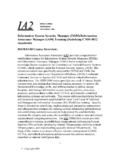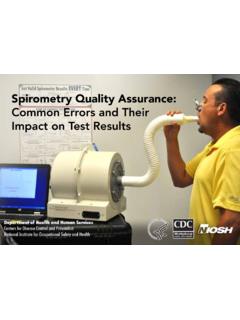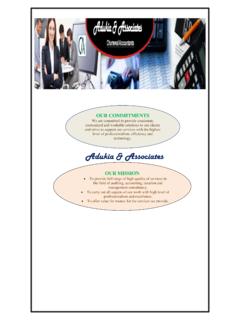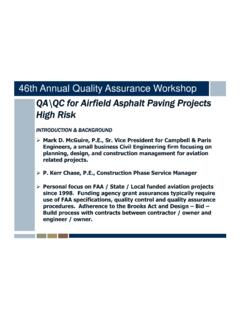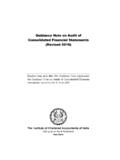Transcription of The NOCA Guide to Understanding Credentialing Concepts 8 …
1 The noca Guide to Understanding Credentialing Concepts Primary Author Cynthia C. Durley, , MBA. Copyright 2005. National Organization for Competency Assurance. All Rights Reserved. The noca Guide to Understanding Credentialing Concepts EDITORS. noca Board of Directors NCCA Commissioners President Chair William Kersten Lawrence J. Fabrey, Senior Vice President, Operations, National Institute Vice President, Measurement Research, Applied for Automotive Service Excellence Measurement Professionals, Inc. President-Elect Co-Chair Cynthia Durley, , MBA Christine Reidy Executive Director, Dental Assisting National Board Executive Director, Commission on Dietetic Registra- tion of the American Dietetic Association Immediate-Past President Susan Eubanks, NCC, NCSC, LPC noca Board Appointee Associate Executive Director, National Board for Certi- Carolyn Lewis, , RN, CNAA.
2 Fied Counselors Principal, The PRINE, LLC. Secretary/Treasurer NCCA Appointees Francine Butler, , CAE. Executive Director, Biofeedback Certification Institute Reed A. Castle, of America Director of Research and Development, Schroeder Measurement Technologies, Inc. NCCA Chair Lawrence J. Fabrey, Paul D. Naylor, Vice President, Measurement Research, Applied Psychometric Consultant Measurement Professionals, Inc. Janice Scheuneman, Sustaining Member President, Quality Assessment Services Richard Goldberg, Esq. Principal, Richard Goldberg & Associates Elected Commissioners Elected Board Members Lynn Anderson Executive Director, Joint Commission on Allied Health Melissa Murer Corrigan, RPh Personnel in Ophthalmology Executive Director, Pharmacy Technician Certification Board Denise Fandel, MS, ATC. Executive Director, Board of Certification, Inc. Christopher Damon, Executive Director, American Medical Technologists Cynthia Miller Murphy, RN, MSN, CAE.
3 Executive Director, Oncology Nursing Certification Carol Hartigan, RN, MA Corporation Certification Director, American Association of Critical Care Nurses Certification Corporation Jan Towers, , NP-C, CRNP. Director, American Academy of Nurse Practitioners Certification Program Public Member Rebecca LeBuhn Chair, Board of Directors, Citizen Advocacy Center 2. The noca Guide to Understanding Credentialing Concepts EXECUTIVE SUMMARY. Nearly every profession uses Credentialing to establish criteria for fairness, quality, competence, and/. or safety for professional services, products, or educational endeavors. In some cases, professions voluntarily develop quality standards of practice; a profession may also be regulated by the State or Federal government. Despite the widespread use of professional designations, Credentialing terms are often misused and general Concepts often misunderstood.
4 The National Organization for Compe- tency Assurance ( noca ), the national membership association for professional certification organiza- tions, developed The noca Guide to Understanding Credentialing Concepts to assist its stake- holders, including legislators, educators, employers, Credentialing agencies, professionals and the public, in Understanding and correctly using Credentialing terms and Concepts . This paper addresses the following: Purposes served by Credentialing Definitions and descriptions of Credentialing terms Processes used in conducting or choosing a psychometrically sound and legally defensible Credentialing examination program Differences between didactic (end-of-course) examinations and professional Credentialing ex- aminations General noca Information ( ). Established in 1977, noca serves as a clearinghouse for information on the latest trends and issues of concern to practitioners and organizations focused on certification, licensure, and human resources development.
5 noca 's accrediting body, the National Commission for Certifying Agencies (NCCA), is the international leader in setting quality standards for Credentialing organizations and grants accredi- tation to those organizations that meet these Standards. noca 's mission is to promote excellence in competency assessment for practitioners in all occupa- tions and professions by: Providing expertise and guidance Developing and implementing standards for accreditation of certification programs through NCCA ( noca 's accrediting body). Providing educational and networking resources Serving as an advocate on certification issues noca 's vision is to: Establish noca as the authority in certification and NCCA as the authority in accreditation of certification programs. Educate the general consumer so they understand the value of voluntary certification and rec- ognize the NCCA seal as representative of quality certification programs.
6 Enhance quality member benefits and resources so all certification organizations will join noca and aspire to NCCA accreditation of their certification programs. Lead the global transformation to excellence in competency assessment. 3. The noca Guide to Understanding Credentialing Concepts WHAT PURPOSE DOES Credentialing SERVE? Credentialing programs serve many purposes including, but not limited to: Protecting the public Establishing standards for professional knowledge, skills, and practice Assuring consumers that professionals have met standards of practice Meeting the requirements of governmental regulators Helping members of an association or organization work with governmental agencies to regulate the profession Developing a customized credential to meet unique needs in the marketplace, because: such a credential does not currently exist; a credential exists, but the organization wishes to differ- entiate itself from its competition.
7 Or because new technologies or procedures have devel- oped into a new scope of practice or body of knowledge Meeting the needs of employers, practitioners, and the public to identify individuals with cer- tain knowledge and skills Furthering a company's overall business goals that is, to ensure that consumers have ac- cess to skilled professionals knowledgeable about the company's products and services Advancing the profession Reflecting an individual's attainment of knowledge of a specifically defined course of study or of technical skills recognized by a manufacturer or service provider Providing the individual certificant with a sense of pride and professional accomplishment Demonstrating an individual's commitment to a profession (and to life-long learning, if the credential is a professional certification, requiring recertification by continuing education, ex- amination, self-assessment, etc.)
8 4. The noca Guide to Understanding Credentialing Concepts DEFINITIONS AND DESCRIPTIONS OF TYPES OF CREDENTIALS. Credit for the sources of these definitions is shared among the resources listed in the bibliography. Credentialing is the umbrella term that includes the Concepts of accreditation, licensure, registra- tion, and professional certification. Credentialing can establish criteria for fairness, quality, competence, and/or safety for professional services provided by authorized individuals, for products, or for educational endeavors. Credential- ing is the process by which an entity, authorized and qualified to do so, grants formal recognition to, or records the recognition status of individuals, organizations, institutions, programs, processes, ser- vices or products that meet predetermined and standardized criteria. The Credentialing process is essentially a method for maintaining quality standards of knowledge and performance, and in some cases, for stimulating continued self-improvement.
9 Credentialing confers occupational identity. Accreditation is the voluntary process by which a nongovernmental agency grants a time-limited recognition to an institution, organization, business, or other entity after verifying that it has met pre- determined and standardized criteria. Professional certification is the voluntary process by which a non-governmental entity grants a time-limited recognition and use of a credential to an individual after verifying that he or she has met predetermined and standardized criteria. It is the vehicle that a profession or occupation uses to differentiate among its members, using standards, sometimes developed through a consensus- driven process, based on existing legal and psychometric requirements. The holder of a profes- sional certification is called a certificant. Licensure is the mandatory process by which a governmental agency grants time-limited permis- sion to an individual to engage in a given occupation after verifying that he/she has met predeter- mined and standardized criteria, and offers title protection for those who meet the criteria.
10 Registration has at least three meanings: one is the governmental process by which a governmen- tal agency grants a time-limited status on a registry, determined by specified knowledge-based re- quirements ( , experience, education, examinations), thereby authorizing those individual's to practice, similar to licensure. Its purpose is to maintain a continuous record of past and current oc- cupational status of that individual, and to provide title protection. A second meaning of registration is simply a listing of practitioners maintained by a governmental entity, without educational, experiential, or competency-based requirements; for example, maintain- ing a list of practitioners on a state registry.'. A third use of the term registration is a professional designation defined by a governmental entity in professional regulations or rules. However, the governmental regulatory body does not itself main- tain a listing or registry of those who purport to meet registration requirements.
